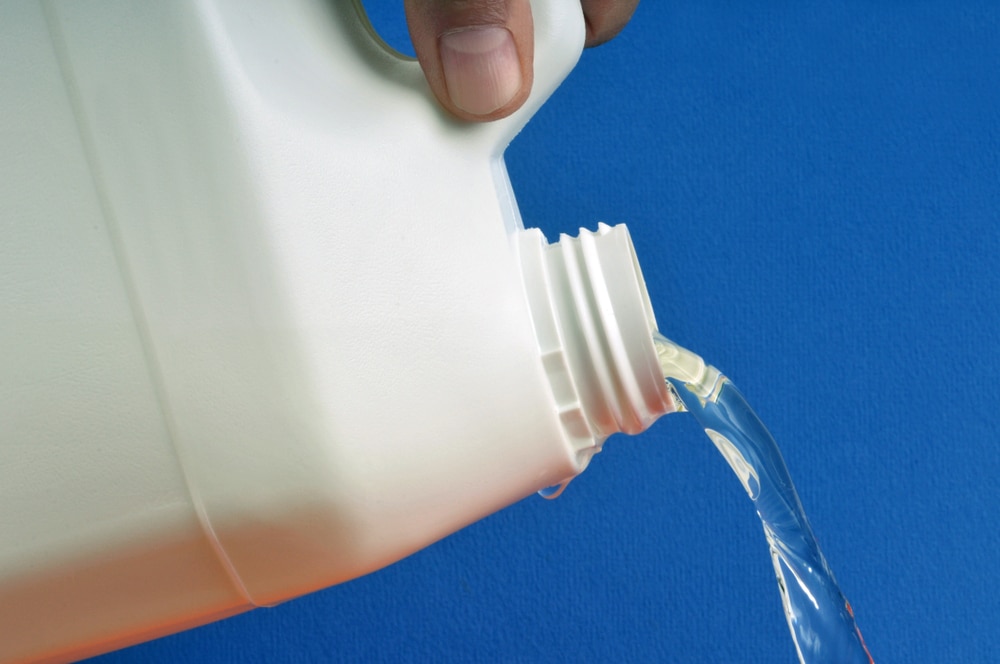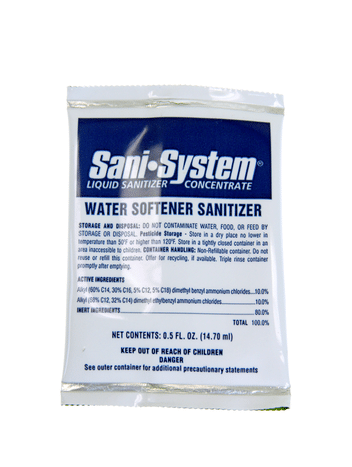How Much Water Should I Run Through A New Filter
Every once in a while, the time may come to make clean your h2o softener system. Whether you've been away for a while on vacation and plant the water foul-smelling or concerned about microorganisms growing in your water supply, prudent homeowners should keep an center on the health of their water softener.
In such cases, it may be natural to ask if you can put bleach in your water softener, given that bleach is a powerful, all-purpose product that is well-known to sanitize and decontaminate water sources. Notwithstanding, the answer to the question depends on a few critical factors.
Can I put bleach in my water softener? The uncomplicated respond is: While bleach is an affordable and efficient way to sanitizing foul-tasting or smelling h2o, it is not always the best solution.
You should consult your user's manual first. Every water organisation has dissimilar internal resins, some of which will withstand bleach, while others will non resist bleach's harsh chemic interference.
In this article, we'll investigate when and where the best times are for running bleach through a water softener, how to disinfect water softeners, and reply some fundamental questions near the use of bleach in h2o softeners.
Don't forget to read our water softener recommendations for city water if you're on the marketplace for a new h2o softener system.
Can I Put Bleach In My Water Softener?
It depends on your h2o softener's educational activity manual. While bleach is a uncomplicated solution for reducing repugnant smells and tastes in some water softeners, other h2o softeners will non tolerate the potent chemical condiment that bleach is.
If your water softener includes instructions not to utilise bleach, manufacturers recommend many specialized chemic additives that will work amend than bleach.
1 solution that water softener owners have found to sanitize their systems that do not apply bleach is elementary table salt. Filling upwardly your water softener cartridge with salt and permitting it to run a few cycles will suffice for cleaning your water softener correctly.
The chemical element of your h2o softener that will determine if you lot can apply bleach or non is the resin. Resin is the purifying substance that helps remove the then-called "hard" chemicals from your water. The resin is saturated with sodium ions in a process that allows information technology to eliminate calcium and magnesium — "hard" chemicals" — from your pipes.
The simply difference from one resin system to another is the blazon of grain or filtration system information technology uses to soften water. In that location are two kinds of resin grain, fine mesh, and hi-cap. It all boils downward to whether you tin can utilise bleach to clean your softener, and you'll have to cheque your didactics transmission commencement before preceding.

How To Sanitize Water Softener
If your water softener system recommends using bleach to clean and sanitize your unit, adept luck! Most experts consider bleach an optimal solution to eliminate bacteria and mildew from water sources.
There are varying opinions on the optimal dosage levels for sanitizing h2o softeners, but the post-obit list some of the nearly consistently effective options.
If You Have A Smaller H2o Softener
This dosage will work for softeners with sizes near the Sears Kenmore 100 to 150 series. Nosotros recommend 1 to 2 tablespoons of bleach (¾ oz) of regular, unscented bleach per cycle for these lower-book units.
Regular-Sized Family Abode Water Softeners
The traditional amount of bleach we recommend for typical homes is one tablespoon (1.5 oz) per cubic foot of resin in your unit of measurement. Since almost family units are most iii cubic feet, users should add 2 oz of bleach per cycle.
If You Take A Larger or Industrial Water Softener
Most of the large water softener units have resin tanks effectually iv cubic feet. Computing with our bleach ratio, that means users should incorporate well-nigh a ½ cup (5 oz) of bleach per cycle.
Steps for Sanitizing a Water Softener With Bleach
Next, we'll outline some of the basic steps for calculation bleach if yous can put bleach in your water softener.
Remember: these steps will only employ if your resin tank can tolerate a bleach cycle. If the educational activity manual indicates that bleach will compromise the softener, check with your manufacturer for the best products to sanitize your softener system.
- Turn off whatsoever other water treatment systems yous take earlier this procedure.
- Start a regular or "extra" regeneration bicycle.
- Add approximately 3 gallons of water into the salt tank if information technology is empty. If you're sanitizing a organization currently in use, skip this stride.
- Add the bleach to the brine tank co-ordinate to the dosages outlined higher up.
- NOTE: Don't cascade the bleach directly on the salts. Information technology could result in an uneven bleach distribution.
- After adding the bleach, cascade in an additional two cups of h2o to rinse off the unit's plastic parts.
- Run the softener through the total regular bike.
- For best practices, run an additional regular water cycle to affluent the bleach from the tank.
- Finally, cheque your salt supply. You'll probable need to add more salt or potassium chloride KCl to the brine tank later on the bleach wheel.
Please refer to our commodity on water softener maintenance for tips on how to properly care for your water softener.+
Alternatives to Bleach For Water Softener

If your h2o softener manufacturer recommends a not-bleach solution to sanitize your brine tank, many alternatives work just equally well, admitting at a higher price on average.
Culligan offers an 0.5oz in-house sanitation pack chosen the "Sani-System" pack. Information technology is an all-in-one solution chemical mixture that users can add to their softeners periodically, merely as a bleach flush would work.
Many manufacturers likewise offer "green sand" sanitizing packs (potassium permanganate) and other oxidizing agents like iodine which works simply besides as bleach, though gentler.
Many users accept found hydrogen peroxide a useful sanitizer for water softener owners whose h2o supply and pipes take absolutely zero atomic number 26 contamination. NOTE: Nosotros recommend you check with your local plumber and water supply resources to ostend the condition of your piping before the use of hydrogen peroxide sanitizers.
Conclusion
The best way to continue your water softener working efficiently (see how to know if its working) is to sanitize information technology periodically. Without cleaning, water hardness will accumulate and reduce your water quality dramatically.
If yous're interested in using bleach to sanitize your water softener, always bank check your manufacturer's instructions earlier moving forward. For those who can use it, bleach is an affordable and piece of cake-to-use solution to eliminate water hardness in a compression.
Whether you're using bleach to reduce bacterial contamination, mildew, or disagreeable smells, homeowners should keep in mind the nearly universal efficiency of bleach in their water softeners.
How Much Water Should I Run Through A New Filter,
Source: https://waterfilterspot.com/bleach-in-water-softener/
Posted by: kittrellkitn1938.blogspot.com


0 Response to "How Much Water Should I Run Through A New Filter"
Post a Comment